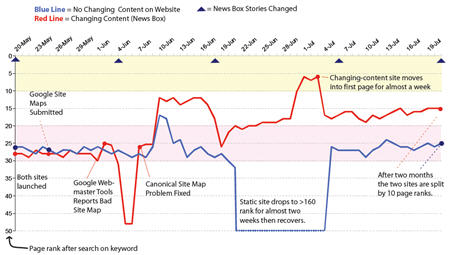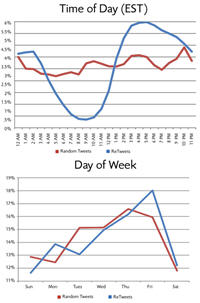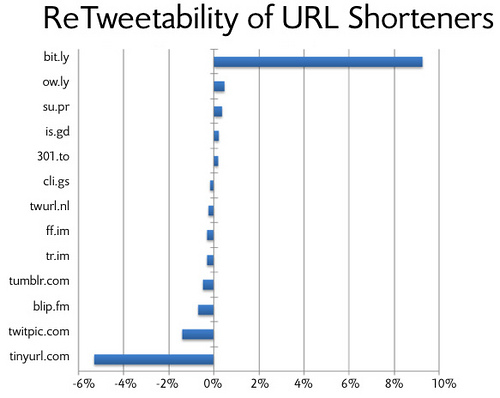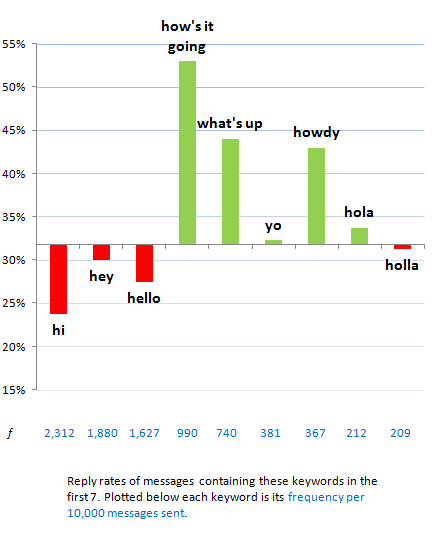Strategies for social media and SEO are so… squishy.
You know what I mean. You can’t measure “authenticity.” You can’t measure “relationships.” You can measure “subscribers” and “followers” and “uniques” but that doesn’t tell you anything about influence or reach or effect. You can measure “page rank” and “search engine position” but those algorithms are shifting and unknowable.
Without units of measurement it’s hard to experiment, and without experiments it’s hard to have data to drive conclusions. This is a sucky situation for the scientist in me.
Recently, however, I’ve come across several sources of empirical, experimentally-sound data sources that do tell us how to be awesome at both SEO and social media.
So on behalf of the geek in all of us: Enjoy.
Changing content leads to higher search engine position

This is really a story within a story — a story of an entrepreneur forced to get hard data to sell his product.
I’ve mentioned Gerry Cullen on several occassions. We did ITWatchDogs together and a weird VC-funded beast before that. Gerry is a great mentor to me and much of the philosophy on this blog is a direct result of his mentorship.
Gerry’s latest venture is Changing Content — a hosted service that puts a scrolling newsbox of relevant content on your home page. Before you scoff that “there’s automated services that do that for free,” this is content hand-picked and edited by a human for just $99/month.
But it was hard to sell. Here’s how a typical sales call looked:
Customer: Why would I want a newsbox?
Gerry: It makes your website more interesting.
Customer: Are you saying I’m not interesting?
Gerry: Our beta customers report that people call them up to talk about the stories on there, so it generates conversations.
Customer: That’s kinda cool, but it’s not tangible enough to justify giving you money.
Gerry: It increases your search engine ranking because you will have changing content with relevant keywords.
Customer: OMG! R U 4 reals? Sweet, I’ll take it. I need all the SEO help I can get.
Gerry: Great!
Customer: So how much does it increase my ranking?
Gerry: I don’t know, but all these bloggers say that regularly changing your content improves search rank.
Customer: Oh, you’re just guessing. You don’t know that it increases search rank.
Gerry: Well…
Customer: No sale. Come back when you have proof.
Every time Gerry got to “improves search rank position because content is changing,” the response was always: “If you prove it, I’ll give you money, otherwise get off my phone.”
So Gerry did an experiment. Two sites, identical in all possible ways: Same subject matter, keyword density, number of words, average word length, page layout, picture size, alt-tags, IP address, domain age, number of inbound links and from which source sites. The only difference was that one site had the newsbox and one didn’t.
The result? See for yourself in this short but powerful report (PDF).
(Bonus lesson: Reports like this with real data get you credibility no matter what your business is. It’s a better marketing technique than any “whitepaper.”)
<H1> doesn’t matter, and 13 other mind-blowing facts from SEOmoz
 SEOmoz has positioned themselves as the leader in SEO tools. If you’ve hired an SEO consultant, changes are they’ve given SEOmoz money.
SEOmoz has positioned themselves as the leader in SEO tools. If you’ve hired an SEO consultant, changes are they’ve given SEOmoz money.
SEOmoz has amassed billions of data points on web page construction, web site interrelationships, and the search ranks. Periodically they crunch this data into reports about what really matters in search engine optimization.
Here’s a great article that summarizes 14 of their recent empirical findings. Some highlights follow (but really, go read the whole article):
- The <H1> tag doesn’t matter for SEO. Use it for site structure and as a guide for people with disabilities or low-grade browsers, but don’t use it to “trick” search engines. This kills me because there’s about 5,245 articles on the Internet stating that <H1> tags are super-duper important.
- “Alt” tags in images really do matter.
- Don’t use query parameters in your URLs (e.g. say “/category/essays/great-post.html” instead of “/post-query?category=essays&title=great-post”). I thought search engines were smart enough to be OK with that, but no.
- Too many links in the footer is a silent killer.
Nine Scientifically Proven Ways to Get Retweeted on Twitter
 Once again HubSpot is leading the charge in real information about inbound marketing and social media. I know, I’ve thrown an elbow at them in the past, but that was just a love tap.
Once again HubSpot is leading the charge in real information about inbound marketing and social media. I know, I’ve thrown an elbow at them in the past, but that was just a love tap.
The latest awesomeness comes from Dan Zarrella, HubSpot’s “Viral Marketing Scientist.” Dan authored the up-coming book aptly named The Social Media Marketing Book, and as part of its promotion he’s created a free, 22-page guide telling you how to get retweeted. (The “cost” is you have to subscibe to his blog.)
But this isn’t Just Another Linkbait Report Constructed By Scraping Tips Off Other Bloggers. This is the result of statistical analysis of 40 million RTs. So what’s that, like four days worth?
For me, one of the big eye-openers was that using TinyURL incurred a massive penalty on the likihood of a retweet:

I use TinyURL for my little “Retweet” button at the top and bottom of blog posts. (Hey You! Do me a solid and nail that button whenever you enjoy a post!) Guess I’ll have to switch to bit.ly.
Oh and a bit of bragging: Turns out my advice about asking for the RT was correct!
Tricks of on-line dating
 My favorite new blog is OkCupid’s. They’re an on-line dating site, but their blog isn’t crap like “10 fun things to do on a first date.” Instead, they crunch numbers.
My favorite new blog is OkCupid’s. They’re an on-line dating site, but their blog isn’t crap like “10 fun things to do on a first date.” Instead, they crunch numbers.
Geeks! I love it!
I mean, where else can you get a heat-map of the European countries and American states in which people are willing to role-play rape fantasies?
But wait, this is relevant. Well, not the rape stuff. Crap, now “rape” appears like three times in this article. This is totally going to weird out my keyword ranking…
Let’s take a look at their analysis of exactly what to say in a first message. What gets you a response?
Go read the article for all the fun facts. This stuff matters because a lot of what you do in business is try to get a response from a stranger. Like:
- Making first contact with a blogger/twitterer who doesn’t know you.
- An email following up with someone who just downloaded a whitepaper or software installer, trying to get them to talk to you.
- Any cold-call.
- Mass advertising in any form.
- A webinar where you hope not to lose half your audience in the first 5 minutes.
Here’s one of their findings: Starting an email with “Hi” (like I have been — oops!) is the worst thing you can do, but starting with something friendly and non-offensive like “Howdy” works well. So what does that mean about all the emails you send to strangers?

And yeah, some of this advice won’t apply to business, cavet caveat, blah blah blah. But it’s a fascinating and unusual glimpse into the human psyche and those guys are funny too, so just read it.
Penelope Trunk tells you how to blog
OK this is sort of a cheat because it’s not exactly empirical, but here’s my argument:
- Penelope has 44,000 RSS subscribers.
- Everything she says is repeated elsewhere by other successful bloggers.
- Nothing is contradicted by the piles of advice at the go-to blogging knowledge sites like ProBlogger and Copyblogger.
- I went from 200 to 7,200 subscribers in 12 months by following all this advice. (More detail on that in a future post…)
 So yeah, it’s not exactly a controlled experiment, but there’s enough evidence in my eyes to recommend it as gospel.
So yeah, it’s not exactly a controlled experiment, but there’s enough evidence in my eyes to recommend it as gospel.
This is her guide. Live it and enjoy your hard-earned success and alienation from all your friends. Oops did I say that out loud? Penelope would tell me not to hold back.
What hard data do you know about? Don’t hog the knowledge: Leave a comment already!
21 responses to “New empirical data for SEO and social media marketing strategies”
Would you consider adding one of those Twitter widgets to a front page to create constantly changing content?
If you mean a widget that uses Javascript to call out and populate the sidebar, then no! Because Google won’t see that.
However there are widgets (e.g. some WordPress widgets might work this way, or could be made to) which actually embed the HTML in the page so search engines see it. That might work.
Even then, however, it’s more useful if the content includes keywords you want in search rankings. Your Twitter stream probably does a decent job at that, so perhaps you’re right, but it wouldn’t be as good as targeted article titles. Still, I just don’t know the answer to that one!
You need to ignore the bit.ly results. It’s the default shortner on Twitter if you just give it a raw URL, so of course it’s the most used and most re-tweeted.
.-= Marty’s latest blog post: martinbarry: Crazier still is those who buy a car made in Germany via this method. It has to be shipped to the country of sale, then shipped back. =-.
Ahh, thanks that’s an excellent point.
Still it doesn’t explain why TinyURLs are so (relatively) unlikely to be RT’ed, right?
Perhaps tinyurl doesn’t leave as much space to add the RT because it’s a longer domain name?
.-= Philip’s latest blog post: DigitalNZ HackFest Christchurch 2009 =-.
The TinyURL result does still stand out like a sore thumb. I’ve been thinking about possible explanations and haven’t come up with much….
– It’s fallen out of favour with most people
– Possibly it’s mostly used by a particular software client or “Tweet about this page” links on websites
– The resulting utilisation skews it to either people with few followers or tweets that are not worth a re-tweet
.-= Marty’s latest blog post: martinbarry: trying to grok super having left .au but the DIC says "ask ATO" (http://is.gd/4RHmp) and the ATO says "ask DIC" (http://is.gd/4RHoC) =-.
I’m late to the party on this one, but for posterity’s sake (meaning other late-comers like me), it looks like Dan properly normalized the RT results. The percentages are ratios between each service’s (e.g. bit.ly) volume in retweets relative to its volume in random (i.e. original) tweets.
So, even with bit.ly’s massive popularity in absolute terms, its RTs have to scale proportionately.
FWIW, I agree with the notion that tinyurl’s length plays against its RTability, although it would be nice to see stats accounting for the overall RT length (i.e. compare only tweets that lie within the 140-char max when RT’d, percentages of RTs that *would* cause overage for each service, etc.).
Awesome article.
I really enjoyed the SEO charts comparing the PageRank of constantly updating content to static content — great stuff.
I recently discovered your blog and have been perusing your top content for about an hour. In that time, I found this article — something I was searching for in past lives for a days. Through serendipity, perhaps, I found you – and won’t miss you again — I just subscribed to your RSS feed.
Great work. Generating objective analytics is difficult at best in the SMM world. The data you link to here is worth goldmines. Thank you for pointing us in the right directions! Concretely! :)
.-= Glenn Friesen’s latest blog post: LinkRoll: Interesting Reading for October 22, 2009 =-.
Thanks for the kind words! Glad it helped.
Finally! I thought there had to be a causation between traffic/PR and content volume since ours would dip every time the editors took a couple days off. Thanks for pointing to the study!
Hey, Jason. Thanks for the shout-out :)
Also, thanks for all those links to interesting research. I especially love the stuff about how to get retweeted. (Sidenote: One of the most surprising things I’ve read in that regard is that tweets that include a four-syllable word are more likely to be retweeted.)
Penelope
.-= Penelope Trunk’s latest blog post: Shifting the balance of power. (Mainstream media stinks.) =-.
Gee which four-letter word is that? Not like you to hold back. :-D
Thanks for the great advice and for being a model of how to bare your soul while also helping the reader become a better, smarter person.
I feel lucky found your blog, it’s a really smart blog for bloggers and readers… :)
Hey, Jason,
just wanted to say ‘Hi’ and let you know that your blog has been a great help lately. Thanks.
Excellent article, by the way, full of actionable advice.
So, now I do not need too much to think about H1 and so on. Thanks for this info .. Because all this time I kept thinking about SEO techniques for my blog. Social media is more effective.
.-= SocialBlogr’s latest blog post: 4 Recommended Twitter Client for Mobile Browser =-.
thanks for this informations, you can visit my website too… but there, we speak french!
Gr8t article. Actually probably 3! My motto is also data and more data, please.
Our experience is that trying to sell.convince/persuade those not predisposed is a WOT – waste of time. The political consultants are very hip about this and there are good brain reasons. It has mainly to do with short-term vs. long-term memory. Our brains are “cognitive misers.”
So finding the people already looking but they can’t find you, is the key. Creating a need is VERY expensive and usually fails. Fear is the best motivator BTW, but you already know that.
The dating information is very relevant since it’s all the social parts of our brains, same in other mammals and primates as well.
Penelope is right on.
Thanks for the extensive article, charts are always great way to drive your point.
.-= Alex Sysoef’s latest blog post: SEO Blogger – Firefox Extention For Simpler Keyword Research =-.
The charts and wealth of information have blown me away. Thank you.
http://localmarketingtucson.com
.-= jake jacob’s latest blog post: Free Enterprise in Tucson – Bruce Myers =-.